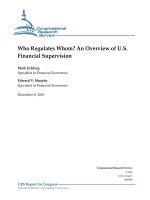an overview of the financial system
Bạn đang xem bản rút gọn của tài liệu. Xem và tải ngay bản đầy đủ của tài liệu tại đây (470.48 KB, 24 trang )
Copyright 2011
Pearson Canada Inc.
2 - 1
Chapter 2
An Overview of the Financial System
Copyright 2011
Pearson Canada Inc.
2 - 2
An Overview of the Financial System
•
Primary function of the Financial System is
financial Intermediation
•
The channeling of funds from households,
firms and governments who have surplus
funds (savers) to those who have a shortage
of funds (borrowers).
•
Direct finance vs. Indirect finance
Copyright 2011
Pearson Canada Inc.
2 - 3
An Overview of the Financial System II
Copyright 2011
Pearson Canada Inc.
2 - 4
Structure of Financial Markets I
Debt Markets
•
Short-term (maturity < 1 year) – the Money
Market
•
Long-term (maturity > 10 year) – the Capital
Market
•
Medium-term (maturity >1 and < 10 years)
Copyright 2011
Pearson Canada Inc.
2 - 5
Structure of Financial Markets II
•
Equity Markets - Common stocks
–
Some make dividend payments
–
Equity holders are residual claimants
•
Primary Market - New security issues sold to
initial buyers
•
Secondary Market - Securities previously issued
are bought and sold
•
Brokers and Dealers
Copyright 2011
Pearson Canada Inc.
2 - 6
Structure of Financial Markets III
Exchanges
•
Trades conducted in central locations (e.g.,
Toronto Stock Exchange and New York Stock
Exchange)
Over-the-Counter (OTC) Markets
•
Dealers at different locations buy and sell
Copyright 2011
Pearson Canada Inc.
2 - 7
Structure of Financial Markets IV
Money and Capital Markets
•
Money market – trade in short-term debt
instruments (maturity < 1 year)
•
Capital Market – trade in longer term debt
(maturity > 1 year)
Copyright 2011
Pearson Canada Inc.
2 - 8
Financial Market Instruments I
Money Market Instruments:
•
Government of Canada Treasury Bills
•
Certificates of Deposit
•
Commercial Paper
•
Repurchase Agreements
•
Overnight Funds
Copyright 2011
Pearson Canada Inc.
2 - 9
Financial Market Instruments II
Copyright 2011
Pearson Canada Inc.
2 -
10
Financial Market Instruments III
Capital Market Instruments – debt and equity
instruments with maturities greater than 1
year.
–
Stocks
–
Mortgages
–
Corporate bonds
–
Government of Canada bonds
Copyright 2011
Pearson Canada Inc.
2 -
11
Financial Market Instruments IV
Additional Capital Market Instruments Include:
•
Canada Savings Bonds
•
Provincial and Municipal Government Bonds
•
Government Agency Securities
•
Consumer and Bank Commercial Loans
Copyright 2011
Pearson Canada Inc.
2 -
12
Financial Market Instruments V
Copyright 2011
Pearson Canada Inc.
2 -
13
Internationalization of Financial Markets
International Bond Market
•
Foreign bonds - sold in a foreign country and
denominated in that country
•
Eurobonds – denominated in a currency other
than the country in which it is sold
•
Eurocurrencies – foreign currencies deposited
in banks outside the home country
Copyright 2011
Pearson Canada Inc.
2 -
14
World Stock Markets
Copyright 2011
Pearson Canada Inc.
2 -
15
Function of Financial Intermediaries I
Financial Intermediaries
•
Engage in process of indirect finance
•
Are needed because of transactions costs and
asymmetric information
•
Transaction costs – time and money spent
carrying out financial transactions
•
Asymmetric information – inequality of
information between counterparties
Copyright 2011
Pearson Canada Inc.
2 -
16
Function of Financial Intermediaries II
1. Reduce Transactions Costs
•
Financial intermediaries make profits by reducing
transactions costs
•
They reduce transactions costs by developing
expertise and taking advantage of economies of scale
Copyright 2011
Pearson Canada Inc.
2 -
17
Function of Financial Intermediaries III
2. Risk Sharing
•
Create and sell assets with low risk characteristics
and then use the funds to buy assets with more risk
(also called asset transformation)
•
Lower risk by helping people to diversify portfolios
Copyright 2011
Pearson Canada Inc.
2 -
18
Asymmetric Information
3. Two types of asymmetric information
a. Adverse Selection
•
Asymmetric Information before transaction occurs
•
Potential borrowers most likely to produce adverse
outcomes are ones most likely to seek loans and be
selected
•
Eg. Akerlof’s Lemons applied to finance
Copyright 2011
Pearson Canada Inc.
2 -
19
Asymmetric Information II
b. Moral Hazard
•
Asymmetric information after transaction occurs
•
Hazard that borrower has incentives to engage in
undesirable activities making it more likely that loan
won’t be paid back
•
E.g. Borrowed funds are used for another purpose.
Copyright 2011
Pearson Canada Inc.
2 -
20
Types of Financial Intermediaries
•
Depository Institutions
–
Chartered Banks
–
Trusts and Mortgage Loan Companies (TMLs)
–
Credit Unions and Caisses Populaires (CUCPs)
•
Contractual Savings Institutions
–
Life Insurance Companies
–
Property and Casual Insurance Companies
–
Pension Funds and Government Retirement Funds
Copyright 2011
Pearson Canada Inc.
2 -
21
Types of Financial Intermediaries II
•
Investment Intermediaries
–
Finance Companies
–
Mutual Funds
–
Money Market Mutual Funds
Copyright 2011
Pearson Canada Inc.
2 -
22
Size of Financial Intermediaries
Copyright 2011
Pearson Canada Inc.
2 -
23
Regulation of Financial Markets
Primary Reasons for Regulation
1. Increase information to investors
- Decreases adverse selection and moral hazard
problems
-
Securities commissions force corporations to
disclose information
2. Ensuring the soundness of intermediaries
-
Prevents financial panics
-
Restrictions on entry/assets/activities, disclosure,
deposit insurance, limits on competition
3. Financial Regulation Abroad
Copyright 2011
Pearson Canada Inc.
2 -
24
Principal Regulatory Agencies









